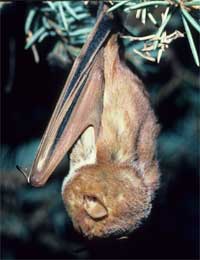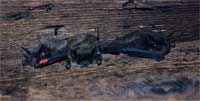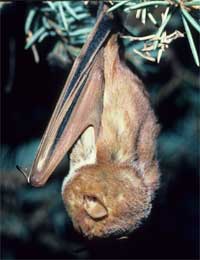 KINGSTON, R.I. – Oct. 27, 2010 – Bats have long played a spooky role during this time of year. However, now more than ever is a scary time for bats in the Northeast.
KINGSTON, R.I. – Oct. 27, 2010 – Bats have long played a spooky role during this time of year. However, now more than ever is a scary time for bats in the Northeast.As a deadly disease sweeps through the bat population from the mid-Atlantic states to New England, there is concern for the potential impact on the local ecosystem, where white-nose syndrome is killing as much as 95 percent of the bat population in some areas.
University of Rhode Island bat expert Peter August, professor in the Department of Natural Resources Science, has seen an impact on the local population. Each year August tracks the bats that stay in the barn on the W. Alton Jones campus in West Greenwich. In years past, there were typically as many as 200 bats in a cluster. Last summer, careful monitoring by the Rhode Island Department of Environmental Management showed the number is down to less than 50.
Each winter, little brown bats – one of most common species in Rhode Island – hibernate in caves in New York and Vermont. Hundreds of thousands of bats stay close together, making it easy for a communicable disease to spread.
“White-nose syndrome has been sweeping through the bat population for the last four years,” August said. “It is spreading through the bat caves and has about a 90- to 95-percent death rate for the bats.”

It is unclear at this point what has changed so dramatically in recent years to put bats in danger. Experts have noticed bats leaving caves earlier each winter, which is a problem because the food bats survive on – mosquitoes and other insects – are not available in the winter months, leading to starvation.
The dramatic mortality rate related to white-nose syndrome presents a major problem for the sustainability of the bat population. Adult bats can have a life expectancy of 30 years. However, even under normal circumstances, 90 percent of bats born every year do not survive the first year of life. The vast majority of young bats do not eat enough during the summer and fall months to survive the winter hibernation, causing them to die before the spring arrives.
With white-nose syndrome killing off adult bats in such high numbers, the long-term prognosis of Little Brown bats in the Northeast appears grim.
“White-nose syndrome is a pretty big mystery, and it is definitely a problem in the Northeast, particularly in New York, Vermont, New Hampshire and Pennsylvania,” August said. “There has been no issue in Europe, and it has really only exploded here in the last few years. It has really come out of the blue, so it’s hard to understand what is happening.
“What we know is that we will not have a Rhode Island bat population like we’ve seen in the past for years to come.”
With bats serving as a major consumer of mosquitoes and moths – an adult bat will eat between 300 and 400 mosquitoes per night – the dwindling bat population could cause a ripple affect in other areas.
“Right now we have more questions than answers,” August said. “Will another species pick up the slack for bats, or will the mosquito population grow out of control?
“It’s a great message to young people interested in science. We should never think that science has provided all the answers. Catastrophes like this come out of the blue, and there is a need to understand the reasons and find the solutions.”

